
 (732) 246-1377
(732) 246-1377
 (732) 246-1377
(732) 246-1377
One of the more common congenital foot conditions is known as clubfoot. It develops while the baby is in utero and cannot be treated until birth. The tendons that connect the heels to the leg muscles are too short, and this may result in clubfoot. Research has indicated it affects males more than females, and it can be seen in approximately one out of 1,000 births in the United States. It is beneficial that treatment begins early in the baby’s life, preferably within two weeks of birth. The type of treatment can range from using manual manipulation that may help to move the feet into a normal position, to possibly having surgery performed. In many cases, the child can begin regular sports activities when of age after the preferred method of treatment. Common signs of clubfoot include the foot turning in and downward, with the toes pointing toward the opposite foot. Additionally, the affected foot, heel, and calf muscles may be smaller than the other foot, but the foot may straighten out as the healing process occurs. If you would like more information about clubfoot, please confer with a podiatrist who can answer any questions you may have and address your concerns.
Congenital foot problems require immediate attention to avoid future complications. If you have any concerns, contact one of our podiatrists of Livingston Footcare. Our doctors can provide the care you need to keep you pain-free and on your feet.
Congenital foot problems are deformities affecting the feet, toes, and/or ankles that children are born with. Some of these conditions have a genetic cause while others just happen. Some specific foot ailments that children may be born with include clubfeet, polydactyly/macrodactyly, and cleft foot. There are several other foot anomalies that can occur congenitally. What all of these conditions have in common is that a child may experience difficulty walking or performing everyday activities, as well as trouble finding footwear that fits their foot deformity. Some of these conditions are more serious than others. Consulting with a podiatrist as early as possible will help in properly diagnosing a child’s foot condition while getting the necessary treatment underway.
What are Causes of Congenital Foot Problem?
A congenital foot problem is one that happens to a child at birth. These conditions can be caused by a genetic predisposition, developmental or positional abnormalities during gestation, or with no known cause.
What are Symptoms of Congenital Foot Problems?
Symptoms vary by the congenital condition. Symptoms may consist of the following:
Treatment and Prevention
While there is nothing one can do to prevent congenital foot problems, raising awareness and receiving neonatal screenings are important. Early detection by taking your child to a podiatrist leads to the best outcome possible.
If you have any questions please feel free to contact our office located in North Brunswick, NJ . We offer the newest diagnostic tools and technology to treat your foot and ankle needs.
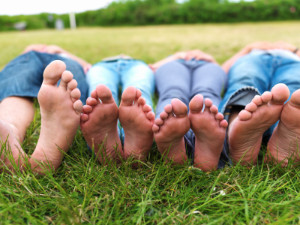
If you are a parent, it is important for you to be doing all you can to minimize the extent to which your child could scrape or develop a wound on their feet. If your child is playing outside in the yard, you might, for instance, clear sharp objects like pointy twigs and rocks that could pierce your child’s skin. There are also many helpful ways in which a parent can immediately treat a wound if it develops on the child’s feet. For example, it might be a good idea to clean the affected area and dry it, applying a bandage. Importantly, if your child’s abrasion causes swelling or a fever, medical attention should be sought out. Contact a podiatrist today if you want to learn more about how to protect your child’s feet.
Making sure that your children maintain good foot health is very important as they grow. If you have any questions, contact one of our podiatrists of Livingston Footcare. Our doctors can provide the care you need to keep you pain-free and on your feet.
Keeping Children's Feet Healthy
Having healthy feet during childhood can help prevent medical problems later in life, namely in the back and legs. As children grow, their feet require different types of care. Here are some things to consider...
Although babies do not walk yet, it is still very important to take care of their feet.
Avoid putting tight shoes or socks on his or her feet.
Allow the baby to stretch and kick his or her feet to feel comfortable.
As a toddler, kids are now on the move and begin to develop differently. At this age, toddlers are getting a feel for walking, so don’t be alarmed if your toddler is unsteady or ‘walks funny’.
As your child gets older, it is important to teach them how to take care of their feet.
Show them proper hygiene to prevent infections such as fungus.
Be watchful for any pain or injury.
Have all injuries checked by a doctor as soon as possible.
Comfortable, protective shoes should always be worn, especially at play.
If you have any questions please feel free to contact our office located in North Brunswick, NJ . We offer the newest diagnostic and treatment technologies for all your foot and ankle needs.
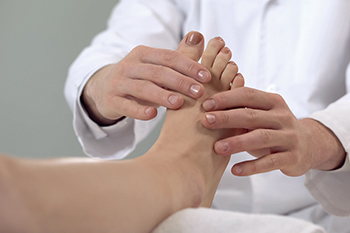
A corn is defined as a small, hardened area of skin that can form on different areas of the foot. A common place a corn can be found is on the outside of the pinky toe. Even though corns are small they can cause the gait or walking style to change. Corns may develop as a result of excess friction that is caused by wearing shoes that do not fit correctly. Some people may experience corns between the toes, and these are referred to as soft corns. When a corn forms on the bottom of the foot it is known as a seed corn. Seed corns may form from clogged sweat ducts, and it may be beneficial to wear socks that are made of breathable materials. If you have a corn on your foot, it is strongly suggested that you speak with a podiatrist who can remove it and offer you effective prevention methods.
If you have any concerns regarding your feet and ankles, contact one of our podiatrists of Livingston Footcare. Our doctors will treat your foot and ankle needs.
Corns: What Are They? and How Do You Get Rid of Them?
Corns can be described as areas of the skin that have thickened to the point of becoming painful or irritating. They are often layers and layers of the skin that have become dry and rough, and are normally smaller than calluses.
Ways to Prevent Corns
There are many ways to get rid of painful corns such as wearing:
Treating Corns
Treatment of corns involves removing the dead skin that has built up in the specific area of the foot. Consult with Our doctors to determine the best treatment option for your case of corns.
If you have any questions please feel free to contact our office located in North Brunswick, NJ . We offer the newest diagnostic and treatment technologies for all your foot and ankle needs.
Foot pain, no matter when it occurs during the day, can be uncomfortable and unpleasant. While it is common for individuals suffering from conditions like plantar fasciitis to experience foot pain at the very beginning of the day, others experience foot pain at night. For example, it is possible to experience ankle pain during the night, and can happen for several reasons. First, tarsal tunnel syndrome can create pain that's worse at night. When nerves in your ankle become compressed and pinched, tarsal tunnel syndrome can develop. Individuals can experience pain not just in the ankles but also numbness and discomfort on the soles of the feet. Since the pressure on these nerves is most potent at night, the pain is typically more acute at this time. If you experience ankle pain at night, it may be caused by nighttime foot cramps. Comparable to the nocturnal leg cramps that usually affect the calves, foot cramps work similarly and can cause shooting pains in the feet. Sometimes, foot cramps can create pain that travels up to the ankle. If you have pain in your ankle that is more noticeable at night, contact a podiatrist to help address the problem.
Ankle pain can be caused by a number of problems and may be potentially serious. If you have ankle pain, consult with one of our podiatrists from Livingston Footcare. Our doctors will assess your condition and provide you with quality foot and ankle treatment.
Ankle pain is any condition that causes pain in the ankle. Due to the fact that the ankle consists of tendons, muscles, bones, and ligaments, ankle pain can come from a number of different conditions.
Causes
The most common causes of ankle pain include:
Symptoms
Symptoms of ankle injury vary based upon the condition. Pain may include general pain and discomfort, swelling, aching, redness, bruising, burning or stabbing sensations, and/or loss of sensation.
Diagnosis
Due to the wide variety of potential causes of ankle pain, podiatrists will utilize a number of different methods to properly diagnose ankle pain. This can include asking for personal and family medical histories and of any recent injuries. Further diagnosis may include sensation tests, a physical examination, and potentially x-rays or other imaging tests.
Treatment
Just as the range of causes varies widely, so do treatments. Some more common treatments are rest, ice packs, keeping pressure off the foot, orthotics and braces, medication for inflammation and pain, and surgery.
If you have any questions, please feel free to contact our office located in North Brunswick, NJ . We offer the newest diagnostic and treatment technologies for all your foot care needs.

Both Type 1 Diabetes and Type 2 Diabetes can produce long-term complications due to increased levels of glucose (sugar) in the blood. They also share several similar symptoms. For instance, when your body struggles to expel excess amounts of sugar from your blood, you may urinate frequently or get excessively thirsty. Diabetes can also make it difficult for cells to absorb glucose in the blood and convert it into energy, causing you to feel fatigued and weak. A decrease in fluids may cause dry mouth and itchy skin, and disruptions in insulin production or use can affect your ability to get energy from food—making you lose weight unexpectedly or be hungrier than usual. Your feet are often the first area to exhibit signs of diabetes. High glucose levels in the blood can cause nerve damage in the feet, which can result in numbness, burning, tingling, or swelling. This can make it difficult for you to feel when you have a cut or bruise on your feet. Poor circulation associated with diabetes can exacerbate this problem by decreasing the body’s ability to heal any such injury, and wounds may develop. This can be problematic in people with diabetes and may lead to far more serious complications if it is not managed and treated properly. That is why a podiatrist is a critical part of your health team should you be diagnosed with diabetes.
Diabetic foot care is important in preventing foot ailments such as ulcers. If you are suffering from diabetes or have any other concerns about your feet, contact one of our podiatrists from Livingston Footcare. Our doctors can provide the care you need to keep you pain-free and on your feet.
Diabetic Foot Care
Diabetes affects millions of people every year. The condition can damage blood vessels in many parts of the body, especially the feet. Because of this, taking care of your feet is essential if you have diabetes, and having a podiatrist help monitor your foot health is highly recommended.
The Importance of Caring for Your Feet
Patients with diabetes should have their doctor monitor their blood levels, as blood sugar levels play such a huge role in diabetic care. Monitoring these levels on a regular basis is highly advised.
It is always best to inform your healthcare professional of any concerns you may have regarding your feet, especially for diabetic patients. Early treatment and routine foot examinations are keys to maintaining proper health, especially because severe complications can arise if proper treatment is not applied.
If you have any questions please feel free to contact our office located in North Brunswick, NJ . We offer the newest diagnostic and treatment technologies for all your foot and ankle needs.
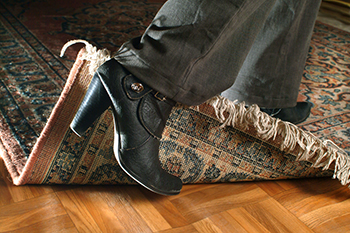
Research has indicated that approximately one in three Americans who are 65 or older will fall, which is a leading cause of hospitalization for adults in New York City. Many people develop a fear of falling, and this can be detrimental to completing daily chores and experiencing new activities. When people fall, their feet are often negatively affected. Ankles or toes may be broken, and this can cause severe pain and discomfort. There are simple prevention techniques that can be implemented to help prevent painful falling episodes. These can include incorporating gentle exercise and stretching routines into the daily regime, clearing clutter in the household, and improving lighting in the living area. Additionally, it is beneficial to have regular physical examinations performed, as this is helpful in monitoring existing medications. Glasses can be updated when the eyes are checked, and it is beneficial to have this done annually. Wearing shoes that fit correctly can be helpful in possibly preventing falls, and maintaining proper foot care is essential in having the feet feel good. Some people find it useful to have grab bars installed in the bath and toilet area, in addition to using a bathmat. If you would like to know about how to protect the feet and how to reduce the number of falls, please ask a podiatrist who can answer any questions you may have.
Preventing falls among the elderly is very important. If you are older and have fallen or fear that you are prone to falling, consult with one of our podiatrists from Livingston Footcare. Our doctors will assess your condition and provide you with quality advice and care.
Every 11 seconds, an elderly American is being treated in an emergency room for a fall related injury. Falls are the leading cause of head and hip injuries for those 65 and older. Due to decreases in strength, balance, senses, and lack of awareness, elderly persons are very susceptible to falling. Thankfully, there are a number of things older persons can do to prevent falls.
How to Prevent Falls
Some effective methods that older persons can do to prevent falls include:
Falling can be a traumatic and embarrassing experience for elderly persons; this can make them less willing to leave the house, and less willing to talk to someone about their fears of falling. Doing such things, however, will increase the likelihood of tripping or losing one’s balance. Knowing the causes of falling and how to prevent them is the best way to mitigate the risk of serious injury.
If you have any questions, please feel free to contact our office located in North Brunswick, NJ . We offer the newest diagnostic and treatment technologies for all your foot care needs.
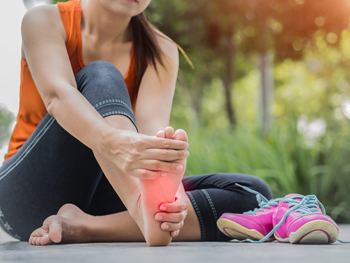
There are basic things you can do as a runner to prevent running injuries and maintain peak performance levels. Choosing the proper footwear should be your first step. When you shop for running shoes, take a few things into consideration, such as the type of surface you’ll be running on, your style of running, and your overall fitness goals. Have your feet measured every time you buy a new pair of running shoes to ensure a proper fit, and make sure you break in the shoes before training in them. Do regular strengthening exercises to build up muscles in your feet, which can help avoid injuries from occurring as well. Keep your feet dry while running to avoid blisters and athlete’s foot by wearing moisture-wicking socks. Your toenails should be trimmed so that they do not press against the tip of your shoes, but be mindful about trimming them too short (in order to avoid an ingrown toenail). After a run, consider massaging and icing your feet to reduce any swelling and help your muscles recover. A podiatrist can offer many more tips on footwear and preventing running injuries, as well as fit you for custom orthotics to address alignment/gait issues, and treat any foot or ankle pain you may have.
Sports related foot and ankle injuries require proper treatment before players can go back to their regular routines. For more information, contact one of our podiatrists of Livingston Footcare. Our doctors can provide the care you need to keep you pain-free and on your feet.
Sports Related Foot and Ankle Injuries
Foot and ankle injuries are a common occurrence when it comes to athletes of any sport. While many athletes dismiss the initial aches and pains, the truth is that ignoring potential foot and ankle injuries can lead to serious problems. As athletes continue to place pressure and strain the area further, a mild injury can turn into something as serious as a rupture and may lead to a permanent disability. There are many factors that contribute to sports related foot and ankle injuries, which include failure to warm up properly, not providing support or wearing bad footwear. Common injuries and conditions athletes face, including:
Sports related injuries are commonly treated using the RICE method. This includes rest, applying ice to the injured area, compression and elevating the ankle. More serious sprains and injuries may require surgery, which could include arthroscopic and reconstructive surgery. Rehabilitation and therapy may also be required in order to get any recovering athlete to become fully functional again. Any unusual aches and pains an athlete sustains must be evaluated by a licensed, reputable medical professional.
If you have any questions please feel free to contact our office located in North Brunswick, NJ . We offer the newest diagnostic and treatment technologies for all your foot and ankle needs.

People who enjoy running are often familiar with blisters. Patients who get them often can generally feel when they are developing blisters and may wear running socks to prevent them. Blisters come from wearing shoes and socks that can cause excess friction and develop as the body’s natural defense to heal damaged skin. It is defined as a small area that resembles a bubble that is filled with fluid, and it immediately forms over the damaged skin. When new skin has formed, the blister will gradually drain as it is no longer needed. There may be existing medical reasons why people get blisters including eczema and psoriasis, in addition to having overly dry skin. A bunion may be the cause of blisters forming on the feet and this often happens from wearing shoes that are too tight. It is beneficial for people who run to gradually build up the skin on their feet as this may lead to getting blisters less often. If you frequently get blisters on your feet and would like to know more information about treatment and prevention, please confer with a podiatrist.
Blisters are prone to making everyday activities extremely uncomfortable. If your feet are hurting, contact one of our podiatrists of Livingston Footcare. Our doctors can provide the care you need to keep you pain-free and on your feet.
Foot Blisters
Foot blisters develop as a result of constantly wearing tight or ill-fitting footwear. This happens due to the constant rubbing from the shoe, which can often lead to pain.
What Are Foot Blisters?
A foot blister is a small fluid-filled pocket that forms on the upper-most layer of the skin. Blisters are filled with clear fluid and can lead to blood drainage or pus if the area becomes infected.
How Do Blisters Form?
Blisters on the feet are often the result of constant friction of skin and material, usually by shoe rubbing. Walking in sandals, boots, or shoes that don’t fit properly for long periods of time can result in a blister. Having consistent foot moisture and humidity can easily lead to blister formation.
Prevention & Treatment
It is important to properly care for the affected area in order to prevent infection and ease the pain. Do not lance the blister and use a Band-Aid to provide pain relief. Also, be sure to keep your feet dry and wear proper fitting shoes. If you see blood or pus in a blister, seek assistance from a podiatrist.
If you have any questions, please feel free to contact our office located in North Brunswick, NJ . We offer the newest diagnostic and treatment technologies for all your foot care needs.
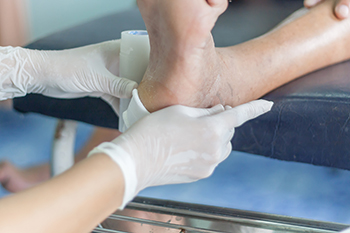
Wounds that develop on the feet can make it difficult to complete everyday activities. A cut or scrape on the foot of a patient who does not have diabetes is easily treated with a bandage for a few days and then removed. The opposite is true with diabetic patients as it can take several weeks for a foot ulcer to heal that began as a cut. Many serious foot wounds require protection against further pressure and patients often wear an “offloading” boot that may accelerate the healing process. Wounds on the feet that do not heal promptly can be the first sign that diabetes may have developed. If the protective boot is worn, it is beneficial that the wound is managed correctly by noticing the amount of ooze and discharge that can affect the skin. Using antiseptics may be suggested as they can help to clean the wound site followed by using special dressings that can reduce the number of bacteria. If you have wounds on your feet, it is strongly advised that you are under the care of a podiatrist who can help you properly treat and manage the condition causing them.
Wound care is an important part in dealing with diabetes. If you have diabetes and a foot wound or would like more information about wound care for diabetics, consult with one of our podiatrists from Livingston Footcare. Our doctors will assess your condition and provide you with quality foot and ankle treatment.
What Is Wound Care?
Wound care is the practice of taking proper care of a wound. This can range from the smallest to the largest of wounds. While everyone can benefit from proper wound care, it is much more important for diabetics. Diabetics often suffer from poor blood circulation which causes wounds to heal much slower than they would in a non-diabetic.
What Is the Importance of Wound Care?
While it may not seem apparent with small ulcers on the foot, for diabetics, any size ulcer can become infected. Diabetics often also suffer from neuropathy, or nerve loss. This means they might not even feel when they have an ulcer on their foot. If the wound becomes severely infected, amputation may be necessary. Therefore, it is of the upmost importance to properly care for any and all foot wounds.
How to Care for Wounds
The best way to care for foot wounds is to prevent them. For diabetics, this means daily inspections of the feet for any signs of abnormalities or ulcers. It is also recommended to see a podiatrist several times a year for a foot inspection. If you do have an ulcer, run the wound under water to clear dirt from the wound; then apply antibiotic ointment to the wound and cover with a bandage. Bandages should be changed daily and keeping pressure off the wound is smart. It is advised to see a podiatrist, who can keep an eye on it.
If you have any questions, please feel free to contact our office located in North Brunswick, NJ . We offer the newest diagnostic and treatment technologies for all your foot care needs.
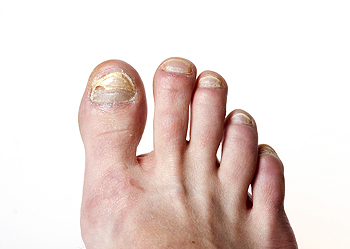
Toenail fungus can be an extremely unattractive and unsightly condition that negatively affects the toenails. Typically, toenail fungus will make the nail brittle or stiff. It can also manipulate the color of the nail, making it brownish or yellowish. Some individuals struggling with toenail fungus may be curious as to whether or not they are able to wear toenail polish to cover up the fungal infection. If an individual has an important event coming up, for example, they might want to hide the unsightly infection with a pop of color from a nail polish. However, there are several things to keep in mind about toenail polish and toenail fungal infections. Using non-medicated toenail polish potentially may be problematic. This is because non-medicated polish, or cosmetic nail polish, might help the fungus thrive and eventually spread. Medicated polish, on the other hand, is specifically meant to inhibit the growth of the fungus. Sometimes, these medicated nail polishes will have antifungal ingredients. A potential downside to relying solely on medicated toenail polish, however, is that it might take a long time to cure the fungal infection. To learn more about treating your fungal infection and the uses of medicated nail polish, contact your podiatrist.
For more information about treatment, contact one of our podiatrists of Livingston Footcare. Our doctors can provide the care you need to keep you pain-free and on your feet.
Toenail Fungus Treatment
Toenail fungus is a condition that affects many people and can be especially hard to get rid of. Fortunately, there are several methods to go about treating and avoiding it.
Antifungals & Deterrence
Oral antifungal medicine has been shown to be effective in many cases. It is important to consult with a podiatrist to determine the proper regiment for you, or potentially explore other options.
Applying foot powder on the feet and shoes helps keep the feet free of moisture and sweat.
Sandals or open toed shoes – Wearing these will allow air movement and help keep feet dry. They also expose your feet to light, which fungus cannot tolerate. Socks with moisture wicking material also help as well.
If you have any questions please feel free to contact our office located in North Brunswick, NJ . We offer the newest diagnostic tools and technology to treat your foot and ankle needs.

There are many reasons why your ankle may hurt. You may have sprained, strained, or fractured your ankle, or ruptured your Achilles tendon. Perhaps some form of arthritis has settled into the ankle joint, or you may have fallen arches. A less common reason for ankle pain is an infection. You are more susceptible to developing an infection in your ankle if you have recently had surgery or have suffered a cut or other form of trauma in the area, and bacteria entered through the open skin. A painful ankle infection is sometimes accompanied by warmth, swelling, or redness in the affected area as well as fever and fatigue. Any infection is a potentially serious condition and should be attended to promptly. If you are having any of the symptoms mentioned here, it is suggested to make an appointment with a podiatrist. They will examine your ankle and make an accurate diagnosis in order to treat the condition properly.
Ankle pain can have many different causes and the pain may potentially be serious. If you have ankle pain, consult with one of our podiatrists from Livingston Footcare. Our doctors will assess your condition and provide you with quality foot and ankle treatment.
Ankle pain is any condition that causes pain in the ankle. Due to the fact that the ankle consists of tendons, muscles, bones, and ligaments, ankle pain can come from a number of different conditions.
Causes
The most common causes of ankle pain include:
Symptoms
Symptoms of ankle injury vary based upon the condition. Pain may include general pain and discomfort, swelling, aching, redness, bruising, burning or stabbing sensations, and/or loss of sensation.
Diagnosis
Due to the wide variety of potential causes of ankle pain, podiatrists will utilize a number of different methods to properly diagnose ankle pain. This can include asking for personal and family medical histories and of any recent injuries. Further diagnosis may include sensation tests, a physical examination, and potentially x-rays or other imaging tests.
Treatment
Just as the range of causes varies widely, so do treatments. Some more common treatments are rest, ice packs, keeping pressure off the foot, orthotics and braces, medication for inflammation and pain, and surgery.
If you have any questions, please feel free to contact our office located in North Brunswick, NJ . We offer the newest diagnostic and treatment technologies for all your foot care needs.